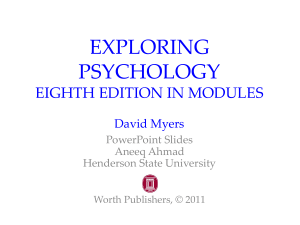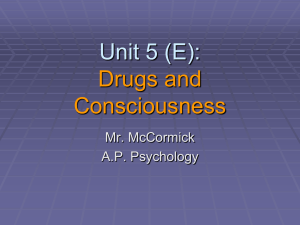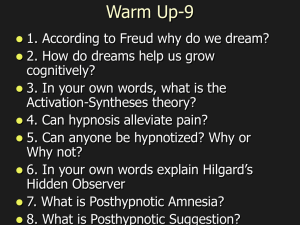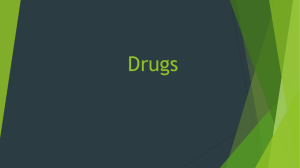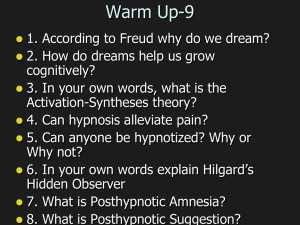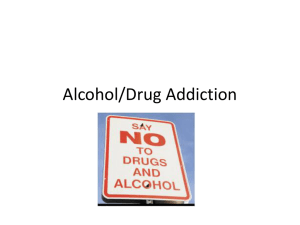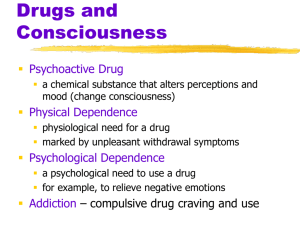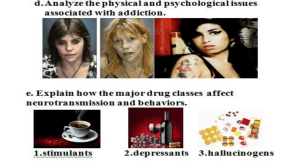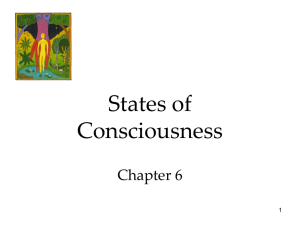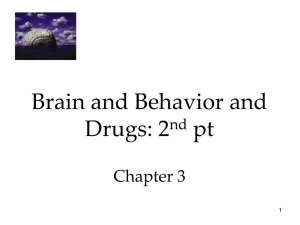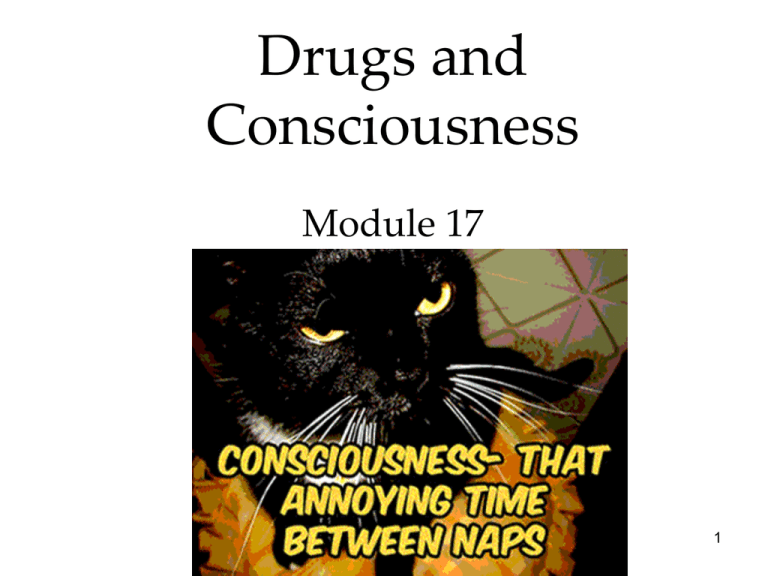
Drugs and
Consciousness
Module 17
1
States of Consciousness Overview
Drugs and Consciousness
Dependence and Addiction
Psychoactive Drugs
Influences on Drug Use
2
Dependence & Addiction
Continued use of a
psychoactive drug
produces tolerance.
With repeated
exposure to a drug,
the drug’s effect
lessens. Thus it takes
greater quantities to
get the desired effect.
3
Withdrawal & Dependence
1. Withdrawal: Upon stopping use of a
drug users may experience undesirable
side effects.
2. Dependence: Absence of a drug may
lead to a feeling of physical pain, intense
cravings (physical dependence), and
negative emotions (psychological
dependence).
4
Addiction is a craving for a chemical substance,
despite its adverse physical & psychological
consequences.
Misconceptions About Addiction
1. Addictive drugs quickly corrupt.
2. Addiction cannot be overcome voluntarily.
3. Addiction is no different than repetitive
pleasure-seeking behaviors.
5
6
Drugs and Consciousness
Psychoactive Drug:
A chemical
substance that alters
perceptions and
mood (affects
consciousness).
Link Psychedelic
Science 47:50
7
Psychoactive Drugs
Psychoactive drugs are divided into three
groups.
1. Depressants
2. Stimulants
3. Hallucinogens
8
Depressants
Depressants are drugs that reduce neural activity
and slow body functions. They include:
1. Alcohol
2. Barbiturates
3. Opiates
9
10
Depressants
1. Alcohol affects motor skills, judgment, and
memory…and increases aggressiveness while
reducing self awareness.
Daniel Hommer, NIAAA, NIH, HHS
11
12
14
Depressants
2. Barbiturates: Drugs that depress the activity of
the central nervous system, reducing anxiety
but impairing memory and judgment.
Nembutal, Seconal, and Amytal are some
examples.
15
Depressants
3. Opiates: Opium and its
derivatives (morphine
and heroin) depress
neural activity,
temporarily lessening
pain and anxiety. They
are highly addictive.
http://opioids.com/timeline
Heroin Crisis at Nat Geo 45:46
16
17
Stimulants
Stimulants are drugs that excite neural activity and
speed up body functions. Examples of stimulants
are:
1.
2.
3.
4.
5.
6.
Caffeine
Nicotine
Cocaine
Ecstasy
Amphetamines
Methamphetamine (speed/crack)
18
Caffeine & Nicotine
Caffeine and nicotine increase heart and
breathing rates and other autonomic functions to
provide energy. Link 2yo smoker
http://www.tech-res-intl.com
19
20
21
Why Do People Smoke?
People smoke because it is socially
rewarding.
Russel Einhorn/ The Gamma Liason Network
Link We love Cigarettes 49:17
22
Why Do People Smoke?
Nicotine takes away
unpleasant cravings
(negative reinforcement)
by triggering
epinephrine,
norepinephrine,
dopamine, and
endorphins.
Nicotine itself is
rewarding (positive
reinforcement).
23
Cocaine
Cocaine induces immediate euphoria followed by a crash.
24
25
26
Ecstasy
Ecstasy or
Methylenedioxymethamphet
amine (MDMA) is a
stimulant and mild
hallucinogen.
Greg Smith/ AP Photos
It produces a euphoric high
and can damage serotoninproducing neurons, which
results in a permanent
deflation of mood and
impairment of memory.
(Croft 2001)
27
28
Methamphetamine
• Methamphetamine increases the release,
and blocks the reuptake of the
neurotransmitter dopamine, leading to
high levels of the chemical in the brain.
29
Link Drug toxicity 6:06
31
32
33
Hallucinogens
Hallucinogens are
psychedelic (mindmanifesting) drugs that
distort perceptions and
evoke sensory images in
the absence of sensory
input.
Housewife on Acid on CNN 5:01
Another person on Acid 8:46
Leary and kids who dropped
acid…creepy 1:14
34
Sacks on Hallucinations
• Link short 1.17
•
http://www.ted.com/talks/oliver_sacks_what_hallucination_reveals_about_o
ur_minds.html
35
36
Hallucinogens
1. LSD: (lysergic acid diethylamide) powerful
hallucinogenic drug that is also known as
acid. Inside LSD 45:24
2. THC (delta-9-tetrahydrocannabinol): is the
major active ingredient in marijuana that
triggers a variety of effects, including mild
hallucinations. Marijuana at National Geographic 45:11
http://static.howstuffworks.com
38
39
40
Near-Death Experiences
(From “Hallucinations” by R.K. Siegel. Copyright
© 1977 Scientific American, Inc. All rights reserved.)
After a close brush with
death, many people
report an experience of
moving through a dark
tunnel with a light at the
end. Under the influence
of hallucinogens, others
report bright lights at
the center of their field
of vision.
41
Influences on Drug Use
The graph below shows the percentage of US highschool seniors reporting their use of alcohol,
marijuana, and cocaine from the 70s to the late 90s.
42
Marijuana Use
The use of marijuana in teenagers is directly related
to the “perceived risk” involved with the drug.
43
44
45
Influences on Drug Use
The use of drugs is based on biological,
psychological, and social-cultural influences.
46
EXPLORING
PSYCHOLOGY
(7th Edition in Modules)
David Myers
PowerPoint Slides
Aneeq Ahmad
Henderson State University
Worth Publishers, © 2008
47
48
49
50

